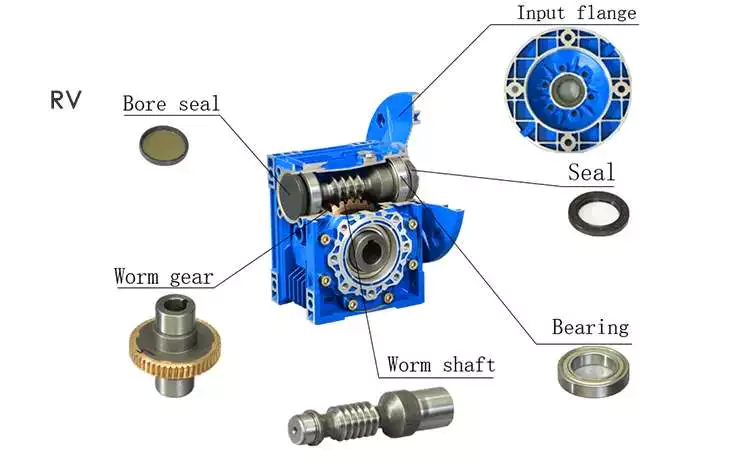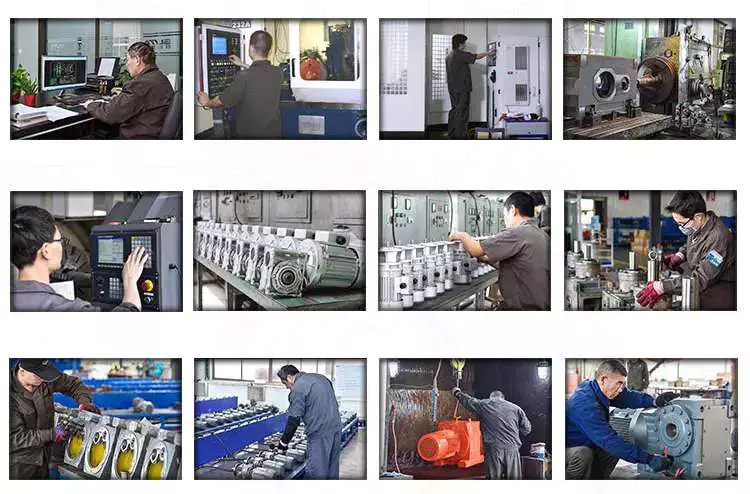Warranty: 1years, 1 Year
Applicable Industries: Building Material Shops, Food & Beverage Factory, Printing Shops
Gearing Arrangement: Helical
Output Torque: 18N.m~64N.m
Input Speed: 1400rpm
Output Speed: 800~170r/min /1000~200r/min
Product name: UDL Series Low RPM Variable Speed Gear Box with Electric Motor
Color: Customer Request
Ratio: 1.4~7
Material: Cast Iron
Certificate: ISO9001
Mounting Position: Foot Mounted. Flange Mounted
Input Form: Mounting Motor
Output Form: Solid Shaft Outpu
Heat treatment: Quenching
Packaging Details: Plastic bags,plywood,pallet
Port: ZheJiang /HangZhou
UDL Series Low RPM Variable Speed Gear Box with Electric Motor
Components:1. Housing: Aluminium Alloy(UDL Series) Cast Iron(UD Series)2. Input Configurations:Equipped with Electric MotorsIEC-normalized Motor Flange3. Output Configurations:Solid Shaft OutputSolid Shaft Output with Output Flange
Models:Foot Mounted – UDL002B3~UD050B3Flange Mounted – UDL002B5~UD050B5
Features:1. Adjustable speed span can be accurate to 0.5~1 r/min2. Can be combined with other types of gearboxes (Such as R Series, K Series, F Series, S Series, RV Series, WB Series cycloid reducers)
3. Compact structure
4. Clockwise and counterclockwise rotation
Installation:B3 Foot-mounted
B5 Flange-mounted
Gearbox Parameters * Input Speed n1=1400r/min
| Models | Power | Ratio | Output Speed(n2)* | Output Torque | Output Shaft Dia. | Output Flange Dia. |
| UDL002 | 0.18KW | 1.6~8.2 | 800~170r/min | 1.5~3N.m | Φ11 | Φ140 |
| UDL005 | 0.25KW | 1.4~7 | 1000~200r/min | 2.2~6N.m | Φ14 | Φ160 |
| UDL005 | 0.37KW | 1.4~7 | 1000~200r/min | 3~6N.m | Φ14 | Φ160 |
| UDL571 | 0.55KW | 1.4~7 | 1000~200r/min | 4~8N.m | Φ19 | Φ200 |
| UDL571 | 0.75KW | 1.4~7 | 1000~200r/min | 6~12N.m | Φ19 | Φ200 |
| UD571 | 1.1KW | 1.4~7 | 1000~200r/min | 9~18N.m | Φ24 | Φ200 |
| UD571 | 1.5KW | 1.4~7 | 1000~200r/min | 12~24N.m | Φ24 | Φ200 |
| UD030 | 2.2KW | 1.4~7 | 1000~200r/min | 18~36N.m | Φ28 | Φ250 |
| UD030 | 3.0KW | 1.4~7 | 1000~200r/min | 24~48N.m | Φ28 | Φ250 |
| UD030 | 4.0KW | 1.4~7 | 1000~200r/min | 32~64N.m | Φ28 | Φ250 |
| UD050 | 5.5KW | 1.4~7 | 1000~200r/min | 45~90N.m | Φ38 | Φ300 |
| UD050 | 7.5KW | 1.4~7 | 1000~200r/min | 59~118N.m | Φ38 | Φ300 |
Customer Visiting Packing & Delivery Related Products Our Company 1. More than 35 years experience in R&D and manufacturing, export gear motors & industrial gearboxes.2. Standardization of the gearbox series3. Strong design capability for large power & customized gearboxes.4. High quality gearboxes and proven solutions provider.5. Strict quality control process, stable quality.6. Less than 2% of the quality complaints.7. Modular design, short delivery time.8. Quick response & professional services
AOKMAN was founded in 1982, which has more than 36 years in R & D and manufacturing of gearboxes, gears, shaft, motor and spare parts.We can offer the proper solution for uncountable applications. Our products are widely used in the ranges of metallurgical, steel, mining, pulp and paper, sugar and alcohol market and various other types of machines with a strong presence in the international market.AOKMAN has become a reliable supplier, CZPT to supply high quality gearboxes.With 36 years experience, we assure you the utmost reliability and security for both product and services.
FAQ Contact Us
Worm gear reducer
A worm gear reducer is a gear reducer that uses a worm gear train to reduce the required force. Unlike traditional gear reducers, these units are small and require low horsepower ratings. This reduces their efficiency, but their low cost and compact design help make up for this shortcoming. However, these gear reducers have some drawbacks, including their tendency to lock up when reversing.
high efficiency
High-efficiency worm reducers are ideal for applications where high performance, repeatability, and accuracy are critical. It consists of an input hypoid gear and an output hypoid bevel gear. The input worm rotates perpendicular to the output worm, so for every revolution of the input worm, the output gear makes one revolution. This arrangement reduces friction (another source of energy loss) in a high-efficiency worm gear to at least two arc minutes.
Compared with worm gear reducers, hypoid gearmotors offer several advantages, including lower operating costs and higher efficiency. For example, hypoid gear motors can transmit more torque even at high reduction ratios. Also, they are more efficient than worm gear reducers, which means they can produce the same output with a smaller motor.
In recent years, the efficiency of worm gear reducers has been dramatically improved. Manufacturers have made great strides in materials, design, and manufacturing. New designs, including dual-enveloping worm gear reducers, increase efficiency by 3 to 8 percent. These improvements were made possible through countless hours of testing and development. Worm gear reducers also offer lower initial costs and higher overload capability than competing systems.
Worm gear reducers are popular because they provide maximum reduction in a small package. Their compact size makes them ideal for low to medium-horsepower applications and they are reticent. They also offer higher torque output and better shock load tolerance. Finally, they are an economical option to reduce the device’s power requirements.
low noise
Low-noise worm gear reducers are designed to reduce noise in industrial applications. This type of reducer uses fewer bearings and can work in various mounting positions. Typically, a worm reducer is a single-stage unit with only one shaft and one gear. Since there is only one gear, the noise level of the worm gear reducer will be lower than other types.
A worm gear reducer can be integrated into the electric power steering system to reduce noise. Worm reducers can be made and from many different materials. The following three-stage process will explain the components of a low-noise worm reducer.
Worm gear reducers can be mounted at a 90-degree angle to the input worm shaft and are available with various types of hollow or solid output shafts. These reducers are especially beneficial for applications where noise reduction is essential. They also have fewer parts and are smaller than other types of reducers, making them easier to install.
Worm gear reducers are available from various manufacturers. Due to their widespread availability, gear manufacturers maintain extensive inventories of these reducers. The worm gear ratio is standard, and the size of the worm gear reducer is universal. Also, worm gear reducers do not need to be sized for a specific purpose, unlike other load interruptions.
A worm gear reducer is a transmission mechanism with a compact structure, large transmission ratio, and self-locking function under certain conditions. The worm gear reducer series products are designed with American technology and have the characteristics of stable transmission, strong bearing capacity, low noise, and compact structure. In addition, these products can provide a wide range of power supplies. However, these worm reducers are prone to leaks, usually caused by design flaws.
Worm gear reducers are available in single-stage and double-stage. The first type consists of an oil tank that houses the worm gear and bearings. The second type uses a worm gear with a sleeve for the first worm gear.
When choosing a gear reducer, it is essential to choose a high-quality unit. Improper gear selection can cause rapid wear of the worm gear. While worm gear reducers are generally durable, their degree of wear depends on the selection and operating conditions. For example, overuse, improper assembly, or working in extreme conditions can lead to rapid wear.
Worm reducers reduce speed and torque. Worm gears can be used to reduce the speed of rotating machines or inertial systems. Worm gears are a type of bevel gear, and their meshing surfaces have great sliding force. Because of this, worm gears can carry more weight than spur gears. They are also harder to manufacture. However, the high-quality design of the worm gear makes it an excellent choice for applications requiring high torque and high-speed rotation.
Worm gears can be manufactured using three types of gears. For large reduction ratios, the input and output gears are irreversible. However, the worm reducer can be constructed with multiple helices. The multi-start worm drive also minimizes braking effects.
Self-locking function
The worm reducer is self-locking to prevent the load from being driven back to the ground. The self-locking function is achieved by a worm that meshes with the rack and pinion. When the load reaches the highest position, the reverse signal is disabled. The non-locking subsystem back-drives the load to its original position, while the self-locking subsystem remains in its uppermost position.
The self-locking function of the worm reducer is a valuable mechanical feature. It helps prevent backing and saves the cost of the braking system. Additionally, self-locking worm gears can be used to lift and hold loads.
The self-locking worm gear reducer prevents the drive shaft from driving backward. It works with the axial force of the worm gear. A worm reducer with a self-locking function is a very efficient machine tool.
Worm gear reducers can be made with two or four teeth. Single-ended worms have a single-tooth design, while double-ended worms have two threads on the cylindrical gear. A multi-boot worm can have up to four boots. Worm reducers can use a variety of gear ratios, but the main advantage is their compact design. It has a larger load capacity than a cross-shaft helical gear mechanism.
The self-locking function of the worm reducer can also be used for gear sets that are not necessarily parallel to the shaft. It also prevents backward travel and allows forward travel. The self-locking function is achieved by a ratchet cam arranged around the gear member. It also enables selective coupling and decoupling between gear members.
high gear ratio
Worm reducers are an easy and inexpensive way to increase gear ratios. These units consist of two worm gears – an input worm gear and an output worm gear. The input worm rotates perpendicular to the output worm gear, which also rotates perpendicular to itself. For example, a 5:1 worm gearbox requires 5 revolutions per worm gear, while a 60:1 worm gearbox requires 60 revolutions. However, this arrangement is prone to inefficiency since the worm gear experiences only sliding friction, not rolling friction.
High-reduction applications require many input revolutions to rotate the output gear. Conversely, low input speed applications suffer from the same friction issues, albeit with a different amount of friction. Worms that spin at low speeds require more energy to maintain their movement. Worm reducers can be used in many types of systems, but only some are suitable for high-speed applications.
Worm gears are challenging to produce, but the envelope design is the best choice for applications requiring high precision, high efficiency, and minimal backlash. Envelope design involves modifying gear teeth and worm threads to improve surface contact. However, this type of worm gear is more expensive to manufacture.
Worm gear motors have lower initial meshing ratios than hypoid gear motors, which allows the use of smaller motors. So a 1 hp worm motor can achieve the same output as a 1/2 hp motor. A study by Nissei compared two different types of geared motors, comparing their power, torque, and gear ratio. The results show that the 1/2 HP hypoid gear motor is more efficient than the worm gear motor despite the same output.
Another advantage of the worm gear reducer is the low initial cost and high efficiency. It offers high ratios and high torque in a small package, making it ideal for low to medium-horsepower applications. Worm gear reducers are also more shock-resistant.

editor by czh2023-02-07
